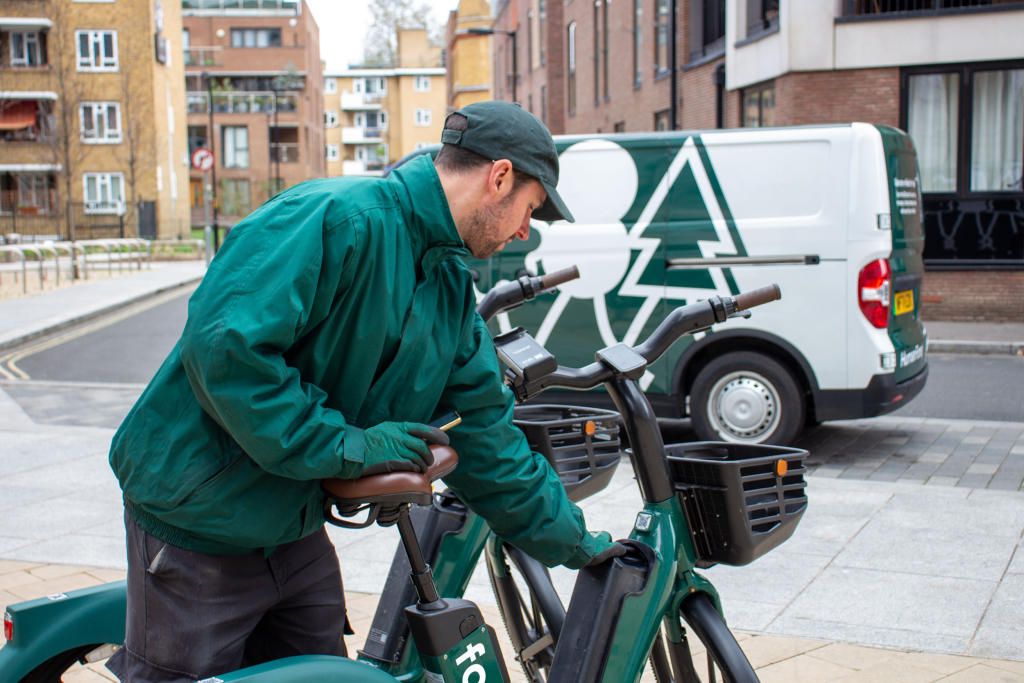By Zag industry expert Caroline Seton, co-founder of shared operator Forest
This Summer the London Fire Brigade (LFB) ran a campaign warning of the dangers associated with e-bike fires. Their report noted that during the first seven months of this year alone, LFB fought 104 e-bike and 19 e-scooter fires, a larger number than in any other year on record.
Yet despite these well-documented fires, it’s striking to note that none of these reported fires have been linked to any of the 20,000+ shared e-bikes spread across the capital.
Shared e-bike and e-scooter batteries closely comply with international safety standards and the operators keep tight controls on the charging infrastructure. However, when it comes to battery sustainability standards our sector is lagging far, far behind.
You can’t have your cake and eat it
Shared e-bike and e-scooter companies most often use swappable batteries, which get replaced on the roadside. This requires the batteries to be lightweight, portable and resilient. Yet, whilst they must be easy for operators to swap in and out, they are also required to withstand attempts by vandals or thieves to remove them from the bike or scooter.
Voi recently reported that it has suffered £500,000 of losses due to e-scooter battery theft in Liverpool. Tier is known to have suffered e-bike battery damage in Dublin earlier this year. Lime experienced a loss of at least 3,000 e-scooter batteries in Paris during the summer months. At Forest, we see on average one battery a week being removed from our bikes, not to the scale that some operators face but one more than we would like.

So, what have shared operators done to reduce the risk of theft whilst also maintaining safety standards? Many operators have selected a type of battery which is incredibly resilient. In fact, Dott claimed in 2021 that its new swappable e-scooter battery could withstand 380 kg of horizontal pull force and 700 kg of vertical pull force. As well as structural resilience, many operator’s battery packs are composed of cells that have been welded together with a dense cake-like material which makes the individual cells almost impossible to access.
However, without access to the individual cells it is almost impossible to repair the batteries if the problem with the battery lies within the cells. The structure also makes replacing individual cells when they reach their end of life stage impossible. Essentially, when one cell is down, the whole battery is out. Each battery contains approximately 100 cells!
Change from within?
These shared e-bike and e-scooter batteries are staggeringly hard to repair or recycle. There are two obvious approaches to remedy this – change the structure of the battery in use, or find a way to work around the hard, cake-like material.
For now, Forest engineers carry out detailed checks on the batteries to establish the cause of failure. Specialist tools enable them to triage the damage and establish the needed method of repair – this includes showing the state and health of the cells.
Batteries with healthy cells point towards the issue being with components in the battery that are more easily replaceable (more than 90% of cases), and where this is identified these repairs are carried out and then placed back into circulation.
However, the process of replacing these components is specialist and time intensive. Moreover, for the remaining 10% of batteries with substantial cosmetic or internal cell damage the options are limited in finding recyclers willing to take on the tamper proof cement protected cells.
One bad apple…
For companies like Forest, sustainability is front and centre of mind and it doesn’t sit well with us that one cell can cause a whole battery to be end of life-d.
On the other hand, it’s a huge risk to enter into an agreement with a new battery manufacturer which provides units with individual cells that can be easily accessed. Gouach is an innovative company which has launched repairable battery products for the micromobility market, but it feels like the rest of the battery space for shared operators is lagging behind with sustainable technology.
Despite Gouach’s assurances that its products are theft protected, the problem of theft is only really able to be tested in reality at scale – it’s unlikely that a thief finds one of the more accessible versions of the batteries if only 10% of the fleet is piloting the new batteries. The loss to the operator if the product is more attractive to thieves is threefold; significant loss of revenue, likely damage to the bike frame during the forced removal of the battery; and still getting no closer to ensuring our batteries and cells are responsibly disposed of.
So, what next?
When I spoke to Alex, CEO and Founder of Gouach, he flagged the inevitability of progress in battery sustainability thanks to the European Commission’s phased implementation of the upcoming “new EU Batteries Regulation”
“The recent introduction of the new European battery regulation marks a significant step towards sustainability in battery technology. By 2027, this regulation mandates the implementation of replaceable cells within batteries. This is a crucial development, as it addresses the fact that approximately 80% of cells within a ‘dead’ battery remain functional.
Alexandre Vallette, CEO & Founder, Gouach
“Gouach stands at the forefront of this eco-friendly initiative. Our value proposition is straightforward: we assist companies in developing compliant, eco-designed batteries. Moreover, production can be facilitated through our expansive network of affiliated factories. For those interested in custom battery solutions, we offer the convenience of designing and quoting batteries online with our user-friendly battery builder tool.”
Nonetheless, for now, a careful cost-benefit analysis will be needed to compare against our existing approach. When considering the outright costs of a replacement battery against the loss rate due to not being able to repair those with damaged cells, the justification of working with an innovative new supplier could be obvious. This would lead to a far more sustainable approach to battery maintenance and management.
We’re sure we’re not alone doing this delicate dance between sustainability and security. Forest is keen to collaborate within the sector to find solutions that work for all shared operators ahead of 2027, to get us to a space where our collective impact on the environment is significantly lessened whilst also not putting our operations at risk.





